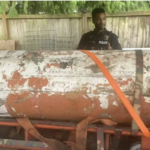Antarctica mysteries to be mapped by robot plane
A group comprising scientists and engineers has arrived in Antarctica to conduct trials on a drone designed to aid in forecasting the effects of climate change.
This unmanned aircraft will chart regions of the continent previously inaccessible to researchers, marking a significant advancement in exploration capabilities.
Before its Antarctic deployment, the drone underwent rigorous testing amidst the harsh weather conditions surrounding Wales’ highest peaks.
The initial mission involves surveying mountainous areas beneath ice sheets to gauge the rate at which ice may melt and contribute to rising global sea levels.
Despite the necessity for an enhanced understanding of Antarctica, current technological constraints hamper scientific endeavors in the region.
Unfavorable conditions like fierce winds, sub-zero temperatures, and sudden storms, compounded by extended periods of darkness during winters, along with logistical challenges in transporting pilots and ample fuel, restrict the use of conventional manned aircraft.
Developed in collaboration between the British Antarctic Survey and UK-based Windracers, the drone boasts repairability in case of malfunctions, a critical feature in remote and harsh environments.
Llanbedr in North Wales, resembling Antarctica’s challenging weather and terrain, served as the testing ground for the drone’s capabilities.
During trial runs amidst strong winds and driving rain, engineer Rebecca Toomey highlighted the drone’s ability to access remote regions without endangering human pilots.
Capable of transporting up to 100kg of cargo over distances of up to 1,000km, the drone carries an array of instruments, including radar and cameras, vital for data collection. Its flight path is pre-programmed while an engineer monitors operations from a computer terminal.
Rebecca will oversee drone operations from the Rothera base in Antarctica, with plans aiming to conduct missions from the UK.
Moreover, the drone’s significantly reduced fuel consumption, ten barrels compared to the traditional aircraft’s 200, underscores its eco-friendliness, minimizing the environmental impact of scientific endeavors.
Data collected by the drone will undergo processing at the British Antarctic Survey headquarters in Cambridge.
Scientist Tom Jordan elaborates on how this data will enrich the BEDMAP2 model, depicting the intricate terrain beneath Antarctica’s ice cover, revealing vast unmapped territories yet to be explored.
“You can see the mountain ridge under the ice here and here. Does that continue across? Are parts under sea level? I don’t know,” he says.
“This survey work is inspiring because it’s a proper blank in the map.”
Antarctica’s vast ice covers huge mountain ranges – some the size of the European Alps – and trenches and valleys. Some areas are below sea level.
Scientists must understand this topography because it determines how quickly the ice will melt.
An ice sheet exposed to warming waters will probably melt more quickly. But if complex mountains block its path, it will decline slower, Tom says.
In its first experiment, radar on the drone will fire radio waves at an ice sheet called Fuchs Piedmont. Some will go into the ice sheet, hit the ground at the base, and bounce back. The drone will listen to those reflections and use them to draw the shape of the land.
“It builds up this picture – going line by line. This is another thing that drones are great for – doing boring things,” he explains.
Current models of global sea-level rise from melting ice sheets have wide margins, but with a better understanding of Antarctica’s topography, Tom says scientists can make more accurate predictions.
“That will help us plan the future,” he says.
The first flights will be in the next few weeks. Other experiments include surveys of marine life like krill, a vital part of the food chain, and surveys of environmentally sensitive areas.

